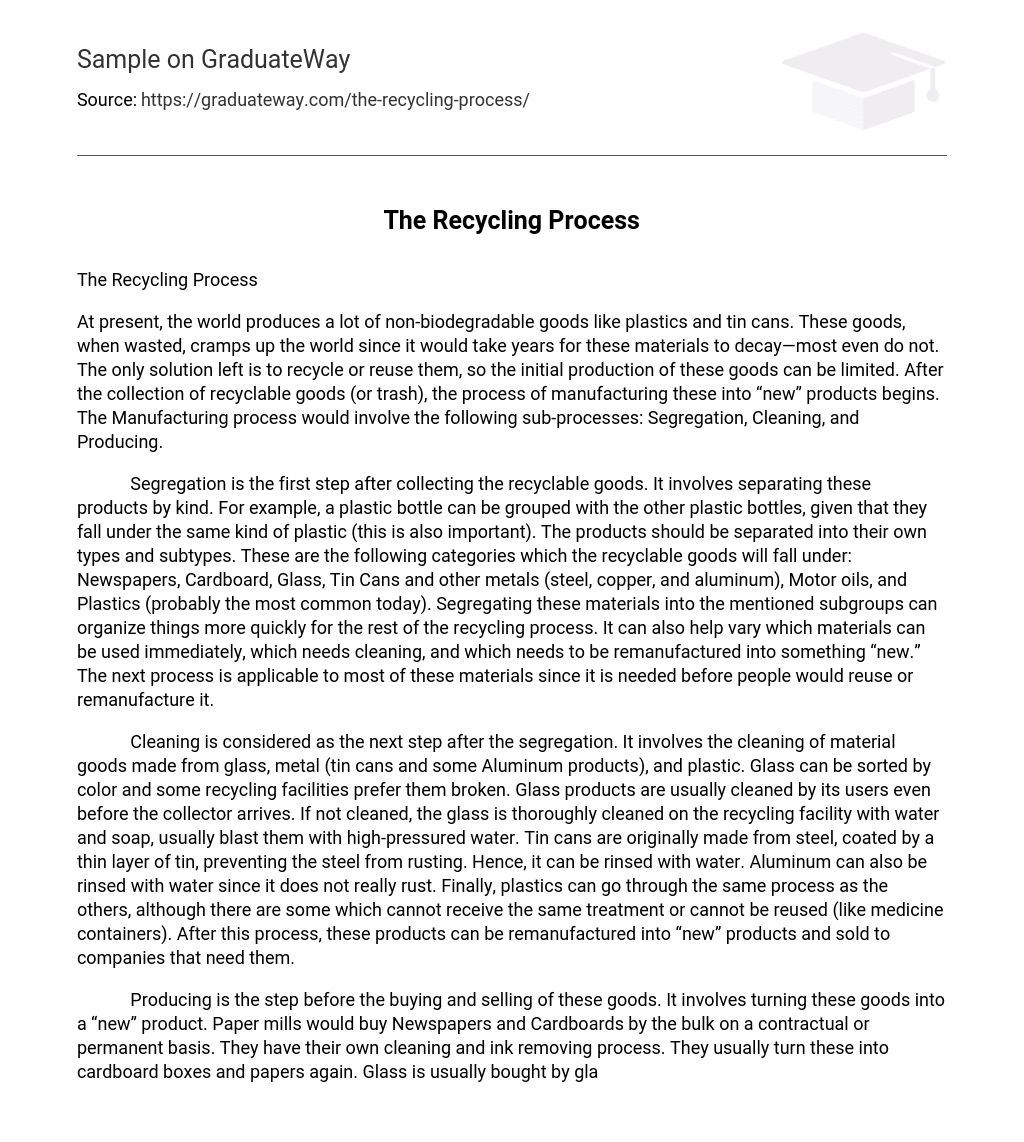At present, the world produces a lot of non-biodegradable goods like plastics and tin cans. These goods, when wasted, cramps up the world since it would take years for these materials to decay—most even do not. The only solution left is to recycle or reuse them, so the initial production of these goods can be limited. After the collection of recyclable goods (or trash), the process of manufacturing these into “new” products begins. The Manufacturing process would involve the following sub-processes: Segregation, Cleaning, and Producing.
Segregation is the first step after collecting the recyclable goods. It involves separating these products by kind. For example, a plastic bottle can be grouped with the other plastic bottles, given that they fall under the same kind of plastic (this is also important). The products should be separated into their own types and subtypes. These are the following categories which the recyclable goods will fall under: Newspapers, Cardboard, Glass, Tin Cans and other metals (steel, copper, and aluminum), Motor oils, and Plastics (probably the most common today). Segregating these materials into the mentioned subgroups can organize things more quickly for the rest of the recycling process. It can also help vary which materials can be used immediately, which needs cleaning, and which needs to be remanufactured into something “new.” The next process is applicable to most of these materials since it is needed before people would reuse or remanufacture it.
Cleaning is considered as the next step after the segregation. It involves the cleaning of material goods made from glass, metal (tin cans and some Aluminum products), and plastic. Glass can be sorted by color and some recycling facilities prefer them broken. Glass products are usually cleaned by its users even before the collector arrives. If not cleaned, the glass is thoroughly cleaned on the recycling facility with water and soap, usually blast them with high-pressured water. Tin cans are originally made from steel, coated by a thin layer of tin, preventing the steel from rusting. Hence, it can be rinsed with water. Aluminum can also be rinsed with water since it does not really rust. Finally, plastics can go through the same process as the others, although there are some which cannot receive the same treatment or cannot be reused (like medicine containers). After this process, these products can be remanufactured into “new” products and sold to companies that need them.
Producing is the step before the buying and selling of these goods. It involves turning these goods into a “new” product. Paper mills would buy Newspapers and Cardboards by the bulk on a contractual or permanent basis. They have their own cleaning and ink removing process. They usually turn these into cardboard boxes and papers again. Glass is usually bought by glass companies which separate the other particles from the glass before placing them in a furnace, turning this into molten glass. These are shaped into bottles, jars, or even stained glass for artworks. Tin cans undergo a reclaiming process—a series of chemical and electrical steps that separates and purifies tin and steel. These are then sold to manufacturing plants that require them. Aluminum is melted, cast on an ingot, and sold to companies, rolled into sheets. These are needed for car bodies, drinks, and the like. Used motor oils are cheaper in the market. After collection, these oils are then tested for hazardous wastes. A series of boiling and heating is done in order to eliminate water and then mixed with other oils before being used in boilers of ships and manufacturing companies. Plastics are resold to companies that produce and require them like soda companies.
The manufacturing process is probably the most important phase of the recycling system since it creates an array of reusable goods to be consumed. Although they would start off as trash, these products can cut costs for the companies that sell them, hence valuable.
Works Cited
Anonymous. “The Recycling Process After Collection.” University of Oregon. 14 July 1998. 2 April 2009. <http://www.uoregon.edu/~recycle/after_collection.html>
Anonymous. “Plastic Recycling Information Sheet.” Waste Online. February 2006. 2 April 2009. <http://www.wasteonline.org.uk/resources/InformationSheets/Plastics.htm>





